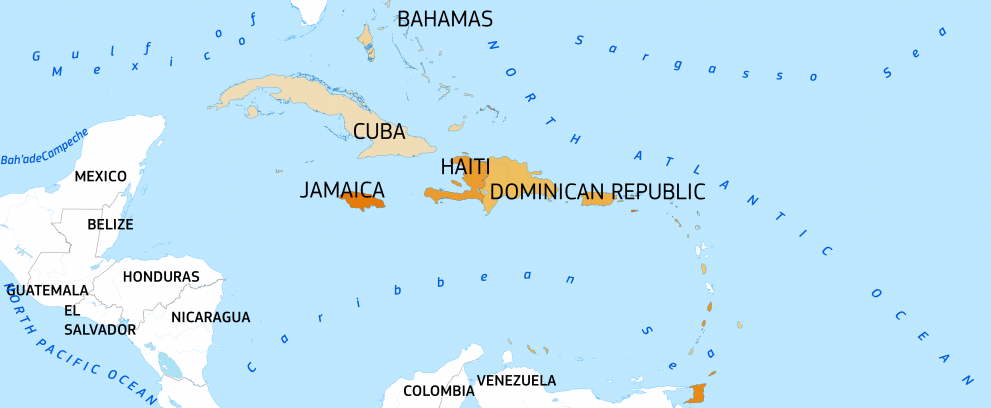Introduction
The Caribbean is the second most disaster-prone region in the world, regularly hit by natural and human-induced disasters. Its Small Islands Developing States are increasingly vulnerable to extreme climatic events, which are becoming more intense, unpredictable, and frequent due to climate change.
In 2023, the region faced 3 major humanitarian challenges at once:
- mixed migrations (Haiti, Cuba and the Venezuelan forced migration and refugee crisis),
- the Atlantic hurricane season (out of 20 tropical storms, 7 turned into hurricanes, 3 of them reaching category 3 or higher),
- other disasters (such as oil spills and flash floods.
What are the needs?
Since 2022, the war in Ukraine has triggered an unprecedented spike in the price of food, inputs, and energy worldwide. Haiti, Dominican Republic and Cuba are the countries in the region with the highest prevalence of insufficient food consumption.
The 2023 hurricane season has been the 4th busiest on record. Despite the strengthening of national and regional disaster management systems, gaps persist in preparedness and response capacity.
The Caribbean coastal areas are witnessing a 10% increase in sea level above the global average. Coastal erosion, limited resources in protecting and maintaining sea defences and waterfronts, and marine resource degradation pose significant challenges to Small Island Developing States.
Higher temperatures, which broke records during the 2023 Caribbean Heat Season, led to increased rates of Aedes aegypti mosquito breeding, biting and disease transmission. More confirmed cases of dengue were recorded in several of the Eastern Caribbean states.
Cuba is going through the most severe crisis since the 1990s. The pandemic aggravated the food crisis, already significantly affected by recurrent droughts, hurricanes, and US-imposed blockades. The scarcity of health supplies and recurrent electricity blackouts have also worsened. Cuba is facing the largest migration crisis since 1959. During the last 2 years, 533,000 Cubans arrived in USA. This figure represents almost 5% of the total population.
Stateless and asylum-seeking people, including more than 1 million displaced Haitians live in extremely vulnerable conditions. They are mainly in the Dominican Republic, which is also hosting 130,000 stateless persons of Haitian origin (the biggest caseload in the Americas).
Around 210,200 Venezuelan refugees and asylum seekers live in the Caribbean, facing integration and regularisation barriers. They also lack access to social services and are often exposed to human rights violations, trafficking, exploitation, and abuse.

How are we helping?
Since 1994, the EU has provided more than €200.5 million in humanitarian aid to the Caribbean (excluding Haiti).
For 2024, the EU has allocated additional €1.14 million to increase the humanitarian scope and maintain protection and education assistance in key countries dealing with refugee caseloads but also affected by a deterioration of a crisis, such as the Dominican Republic. An additional €1 million was allocated in 2024 on disaster preparedness, to complement and cover some key gaps on early warning systems in the Dominican Republic.
In April 2024, the EU contributed with €200,000 to the Disaster Response Emergency Fund (DREF) of the International Federation of Red Cross and Red Crescent Societies (IFRC), to support Cuba's response to the flash floods that affected four provinces. The funding supported the distribution of hygiene kits, mattress, kitchen sets, mosquito nets, tarpaulins, and shelter tool kits.
In 2023, the EU allocated €500,000 to respond to the humanitarian crises in the Caribbean, focusing on forced displacement in Trinidad and Tobago and the Dominican Republic.
Disaster Preparedness in the Caribbean aims at covering gaps in terms of preparedness and response capacities and at strengthening communities, local, national, and regional institutions’ resilience.
The main priorities for intervention, established in coordination with regional bodies, are:
- risk-based and anticipatory actions,
- climate and environmental resilience,
- urban preparedness.
In 2023, the EU allocated €4 million to disaster preparedness programming in countries of the Caribbean sub-region, with a focus on enhanced preparedness and logistics capacity; shock responsive social protection systems; safe school initiatives and urban preparedness, among others.
A Memorandum of Understanding on disaster risk management has been established as a new collaboration instrument between the European Union and the Latin America and Caribbean region. This agreement focuses on disaster preparedness and risk management, and it became effective in May 2024. Regional disaster management agencies, including the Caribbean Disaster Emergency Management Agency (CDEMA), have signed as parties to the agreement.
Linking emergency relief and longer-term development interventions strengthen the ability of institutions and vulnerable populations to cope with disasters and be better prepared.
Last updated: 15/05/2024
Facts & figures
2 consecutive hurricane seasons (2022 – 2023) with 2 or more mayor hurricanes.
Around 210,200 Venezuelan refugees and asylum seekers live in the Caribbean
130,000 stateless persons of Haitian origin (the biggest caseload in the Americas) living in extreme difficult conditions in the Dominican Republic
More than 250,000 deportations in 2023 due to the irregular migration status in the Dominican Republic (up from 154,333 in 2022).
EU humanitarian funding:
€ 200.5 million since 1994 (funding excluding Haiti*)

